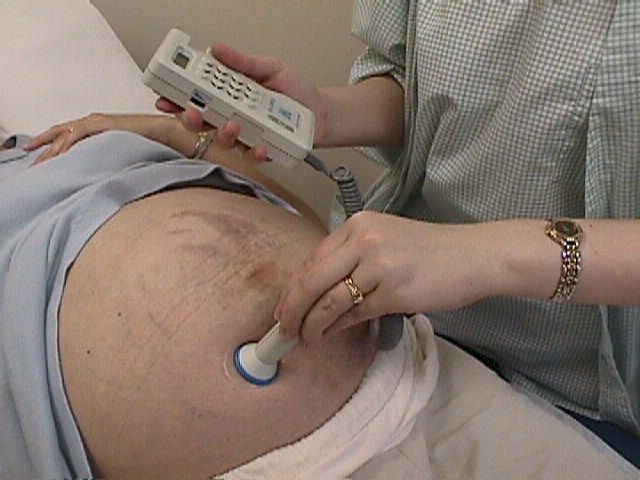Fetal Heart Beat
Although the fetal heart begins beating as early as the 5th week after the
LMP, your ability to detect it will be limited by your equipment.
An ultrasound machine usually will enable you to see a heartbeat by 5 to 6 weeks
gestation if equipped with a vaginal probe. Abdominal ultrasound will
usually see the heartbeat by the 7th-8th week of pregnancy.
If you use a Doppler ultrasound fetal heartbeat detector, you can,
with effort, usually hear the heartbeat by 12-14 weeks gestation and
routinely after that.
-
 You aren't really hearing the heartbeat. You are hearing the
amplified "beat frequency" generated by the interaction between the
outgoing ultrasound signal, and the returning ultrasound signal. When
the outgoing signal is reflected back by a moving object (fetal heart),
then the returning signal has a slightly higher frequency (if the object
is moving toward the transducer), or slightly lower frequency (if the
object is moving away). This is called the Doppler shift. Every so
often, the peaks and valleys of these slightly different frequencies are
superimposed on each other, creating a much louder sound, that happens
to be in the audible range. It is this sound that you are hearing. You aren't really hearing the heartbeat. You are hearing the
amplified "beat frequency" generated by the interaction between the
outgoing ultrasound signal, and the returning ultrasound signal. When
the outgoing signal is reflected back by a moving object (fetal heart),
then the returning signal has a slightly higher frequency (if the object
is moving toward the transducer), or slightly lower frequency (if the
object is moving away). This is called the Doppler shift. Every so
often, the peaks and valleys of these slightly different frequencies are
superimposed on each other, creating a much louder sound, that happens
to be in the audible range. It is this sound that you are hearing.
Listen to a fetal heartbeat
The normal rate is generally considered to be between 120 and
160 beats per minute.
-
The rates are typically higher (140-160) in early pregnancy,
and lower (120-140) toward the end of pregnancy.
-
Past term, some normal fetal heart rates fall to 110 BPM.
-
There is no correlation between heart rate and the gender of
the fetus.
Use a coupling agent (eg, Ultrasound jel, surgical lubricant, or even
water) to make a good acoustical connection between the transducer and the
skin.
Doppler fetal heartbeat detectors are moderately directional, so unless you
happen to aim it directly at the fetal heart initially, you will need to move
it or angle it to find the heartbeat.
Confirm a normal rate, and listen for any abnormalities in the rhythm of
the fetal heart beat.
Using a DeLee stethoscope (equipped with a head-mount), you can
sometimes hear the heartbeat by 16 weeks but unless you are practiced
with it, you won't hear it until 20 weeks, at which time the mother can
usually tell you that she feels the baby moving.
Using a conventional stethoscope, you may never hear the fetal
heartbeat. |

 You aren't really hearing the heartbeat. You are hearing the
amplified "beat frequency" generated by the interaction between the
outgoing ultrasound signal, and the returning ultrasound signal. When
the outgoing signal is reflected back by a moving object (fetal heart),
then the returning signal has a slightly higher frequency (if the object
is moving toward the transducer), or slightly lower frequency (if the
object is moving away). This is called the Doppler shift. Every so
often, the peaks and valleys of these slightly different frequencies are
superimposed on each other, creating a much louder sound, that happens
to be in the audible range. It is this sound that you are hearing.
You aren't really hearing the heartbeat. You are hearing the
amplified "beat frequency" generated by the interaction between the
outgoing ultrasound signal, and the returning ultrasound signal. When
the outgoing signal is reflected back by a moving object (fetal heart),
then the returning signal has a slightly higher frequency (if the object
is moving toward the transducer), or slightly lower frequency (if the
object is moving away). This is called the Doppler shift. Every so
often, the peaks and valleys of these slightly different frequencies are
superimposed on each other, creating a much louder sound, that happens
to be in the audible range. It is this sound that you are hearing.